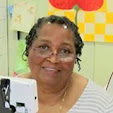The hardest part is deciding which piece goes on top of another. The piece on the top is the piece that gets the seam allowance turned to the back and glued down. It is important to mark you pattern with lines, numbers and notes that help you reassemble the piece
What is pictured is for demonstration only and is not the project I teach in my "Round Flower" class. No matter how large or small a project you are working on, cut apart for use no more than two pieces from the big drawing made on freezer paper or in classes I teach the printed pattern which is glued to the mat side of freezer paper so you can iron the shiny side of the freezer paper to the front side of the fabric. You are always working with the front side of the fabric and you always add a 1/4" seam allowance to all side of the pattern piece.
Cut out a piece, apply glue to the seam allowance area and turn the seam allowance to the back. Assemble one section at a time to make a larger piece.
Assemble them as pictured below
Turn back one edge of the vein, glue down and glue to the seam allowance of the corresponding leaf piece. Repeat for the second side of the leaf. This become a larger shape that can be set aside for later.
Make sure as you glue one piece to another that you use an iron set on cotton, without steam, to dry the glued used to attach one piece to another, thus making the piece more secure and movable. The larger the piece gets as you add more pieces, the more care needs to be taken in making sure the parts are glued securely before moving about before adding stitches to secure all the parts.
Just like a puzzle, if it was a complete picture that was cut into shapes, no matter how complex, they will go back together if you match the right piece. When you are having trouble trying to make a piece fit, it is either the wrong piece or you are trying to put two pieces together that do not go together.
Continue working in an orderly manner, remember that all of the pieces go on top of the background pieces.
If there is inner curved edge piece that won't turn smoothly to the back you should make a few clips into the seam allowance in the concave section.

 The center circle is the last piece to be turned under all the way around and glued in place. Make sure you have a tick mark on at least one pedal of a flower that tells you where the match point on circle corresponds with a pedal.
The center circle is the last piece to be turned under all the way around and glued in place. Make sure you have a tick mark on at least one pedal of a flower that tells you where the match point on circle corresponds with a pedal.
After all the pieces are in place and you have removed all the ironed on pattern pieces, you can secure the pieces with hand applique stitches or machine stitches. I prefer using a blind hem stitch with a fine thread, embroidery weight, either Mettler's cotton embroidery 60 wt thread or Isacord 40wt. The closer to the color of the fabric your thread choices are the less noticeable the machine or hand stitching is.
Good luck.If you have any questions let me know.








